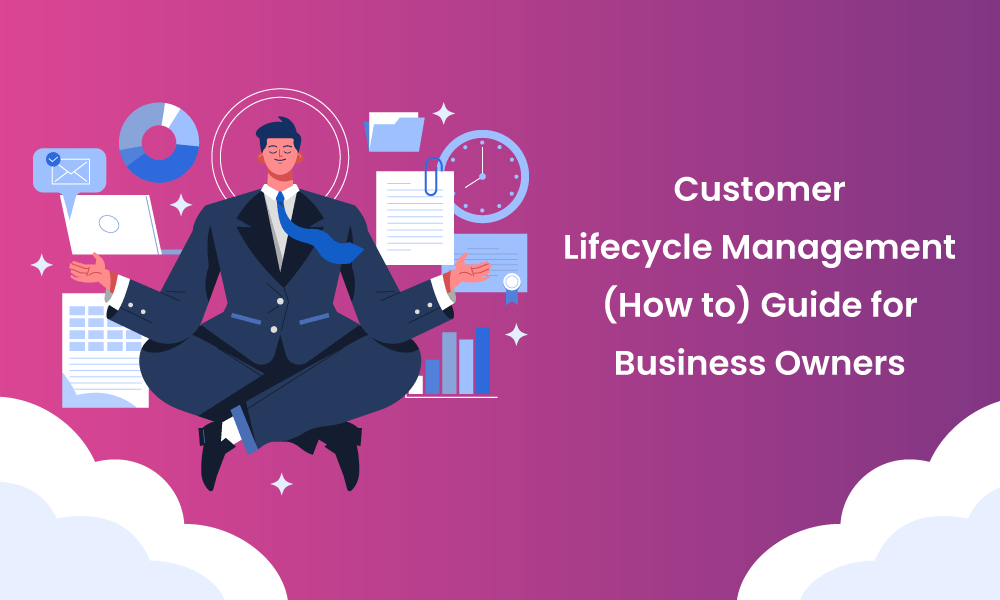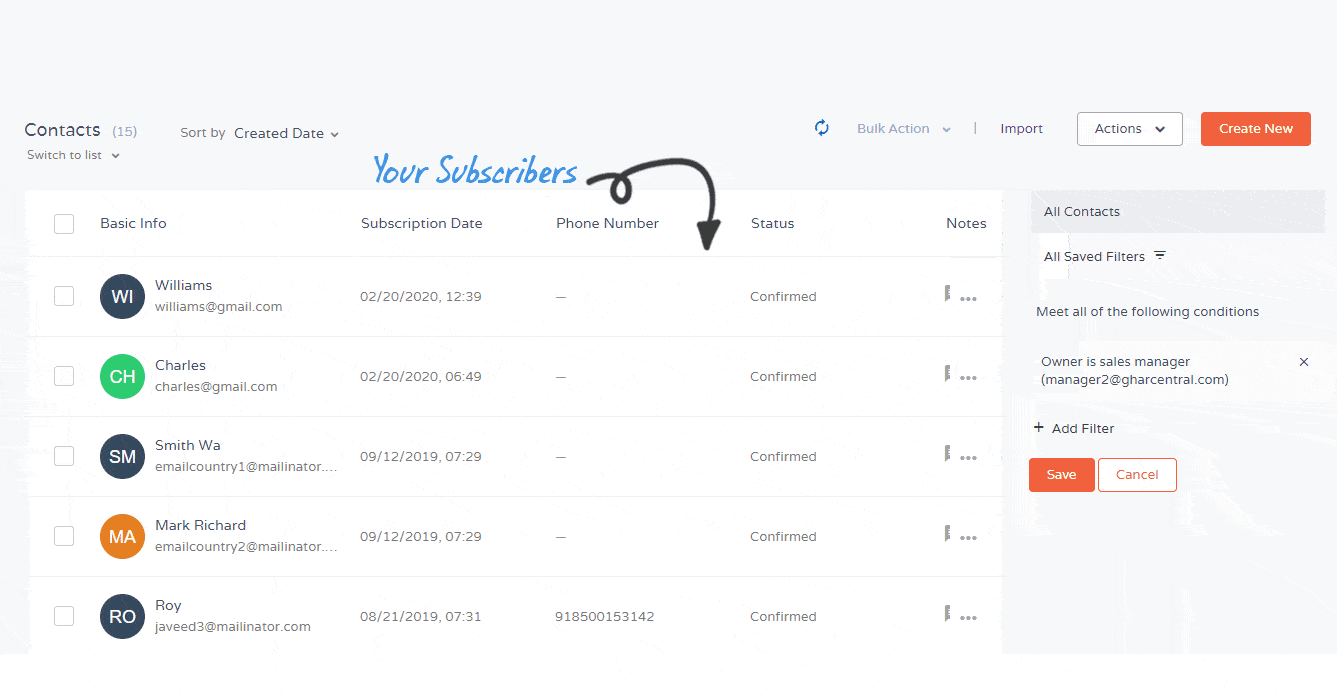For decades, the customer lifecycle management approach has remained popular, focusing on nurturing customer relationships and boosting customer retention to drive increased sales.
Customer relationship management (CRM) tools have evolved to prioritize enhancing customer experiences, leveraging customer data to design tailored campaigns and deliver exceptional customer service throughout the customer journey.
Customer lifecycle management empowers businesses to identify optimal moments to elevate their services or products, driven by the enhanced customer lifetime value (CLV) that comes with nurturing long-term customer relationships.
In this blog post, we delve into the following key aspects:
- Understanding customer lifecycle management (CLM): We define and explore the concept of customer lifecycle management, shedding light on its significance in driving business success.
- Recognizing the importance of customer lifecycle management: Discover the inherent value of implementing a strategic approach to managing the customer lifecycle, and how it directly impacts revenue generation.
- Unveiling the five customer lifecycle stages: Gain insights into the five key stages that comprise the customer lifecycle, enabling businesses to effectively engage and cater to customers at each stage of the customer journey.
- Calculating customer lifetime value (CLV): Learn the methodology behind determining customer lifetime value, a vital metric for evaluating the long-term revenue potential of your customer base.
- Mastering customer lifecycle management: Acquire practical tips and strategies to excel in customer lifecycle management, unlocking the full potential of this approach for your business.
- Leveraging EngageBay for customer lifecycle management: Discover how EngageBay’s robust CRM platform can be utilized to effectively achieve your customer lifecycle management objectives, driving revenue growth and customer satisfaction.
Join us on this journey as we explore the transformative power of customer lifecycle management and provide actionable insights to help you excel in this vital aspect of business success.
Table of Contents
What Is Customer Lifecycle Management or CLM?
The customer lifecycle is a marketing term used to describe customer behavior in a given market, and the period your customer will be interacting with you. It has been designed to ensure customer satisfaction while maximizing sales opportunities during the customer journey.
It is important to understand the customer lifecycle concept because this way of thinking about customer management can maximize operational efficiency through cost-effective customer retention, customer lifetime value (CLV), and customer satisfaction.
The customer lifecycle approach helps you identify when to improve your services or products based on customer behavior, by using customer-specific campaigns that are personalized for each new and changing customer segment. This is the best way to achieve customer satisfaction while increasing sales opportunities and getting a better bottom line.
With the right CLM or CRM tools, you have the chance to glean pertinent information for key metrics.
You can then use this customer behavior data to improve the reputation of your brand, generate higher rates of customer retention, and make each customer journey a more pleasant experience.
Here’s a great video about customer lifecycle management from Automation Ninjas:
It’s important to mention now that the average lifecycle model for customers has more than one stage or cycle.
This is something we will dive into fully later in this article.
Why Is Customer Lifecycle Management Important?
With customer lifecycle management, you have a greater chance of successfully cross-selling and upselling to happy customers.
Also, a customer lifecycle management software offers tools to:
- Extend warranties
- Add service agreements
- Make new offers at the end of the product lifecycle
The Possibility of Extending Warranties
When your customers buy a tech product or any other high-end goods, they’re typically offered a warranty to go along with their purchase.
This may protect their new investment over the course of two, maybe three or even five years, sometimes as many as 10 years.
If the customer happened to spend a lot of money on this product, then surely they will want to retain the protection that they enjoyed under the warranty.
After all, should their product malfunction or even break now, they would have to pay for its repair or replacement out of their own pockets.
That’s why offering warranties — and the ability to extend warranties through a loyalty or service program — is crucial for your business. Having a CLM software can streamline this process.
Adding a Service Agreement
Have you come across service agreements? Service agreements are considered unattached assets, but they operate the way warranties do.
In other words, should your customers have a problem with the product they bought, including it failing or breaking, they’d rely on the service agreement.
This may pay for the costs of a replacement product so the customer doesn’t necessarily have to.
Once more, by presenting a means of protecting the customer’s investment, such as through the service agreement, their sense of loyalty towards your company goes way up.
Making New Offers as Products Reach the End of Their Lifecycle
Another wonderful benefit of the customer lifecycle management process is the ability to swoop in with a perfectly timed offer.
You can assume when a customer might reach the highest point of your sales funnel, using this information to your advantage.
Armed with the data you now have, you can present an offer that should be very much well-received by your customer. This time, instead of presenting an extended warranty or a service agreement, you’d want to introduce a related product to the one the customer used and loved so much.
Read also: 6 Free Marketing Software Marketers Must Try Today
The Five Customer Lifecycle Stages
Let’s discuss each of these customer lifecycle stages in detail now.
Approach
The first customer lifecycle stage is the approach stage. Most of the work is on the shoulders of the sales and marketing teams here, as the customer is just a lead at this point.
The goal is to convert them to customers, but before that can happen, the sales and marketing teams must ensure the leads are even worth working with.
Through lead scoring and segmentation, you study the behavior of a group of leads that could become potential customers.
Each time they do something, points get added or deducted from their score. If a lead were to unsubscribe from your email newsletter a week after joining, for example, then that would impact their score negatively.
The more weight you give to an action, such as buying a product vs. opting in, the more points they would get.
With segmentation, you’d split your leads based on demographics like age, gender, location, occupation, job title, income, pain points, and more. The most valuable leads become prospects, marketing-qualified leads or MQLs, and sales-qualified leads or SQLs.
Acquisition
After the approach stage, your leads enter the acquisition lifecycle phase.
At this point, you have leads that are very interested or prospects who are quite likely to become customers.
A dedicated sales and customer service rep should be available to answer all the inevitable questions and concerns your leads will have.
Besides that, your marketing and sales teams must do their best to showcase the usefulness and value of the product or service you’re trying to sell to each group of leads.
Remember that segmentation still matters here, as even the most qualified leads won’t have identical pain points. While segmenting your leads, you may try to market several products or services, dividing these among your various audience groups. This will help in targeted marketing efforts, and can enhance acquisition.

Development
If you vetted your leads with a fine-tooth comb, then they should have continued through the sales pipeline without exiting at any point.
These customers may have even taken up your offers on products or services, but your work isn’t done yet. Instead, you want to continue nurturing and engaging with the new customer to retain them.
You can send surveys to get quality and valuable feedback. Make sure you use the information presented in these surveys to make positive changes to your customer lifecycle marketing and sales approaches.
Retention
The fourth stage is retention.
Now, you have to tailor your marketing and sales content based on feedbacks so it’s more personalized towards the needs of your customers.
In essence, you need to retain them. Use upselling and cross-selling, as well as continued support to retain your customers better.
Loyalty
In many lifecycle management models, the last stage is loyalty, which marks the last stage of the lifecycle.
The customer could become almost like a brand advocate, referring your products and services to others in their professional and personal lives.
Now, the customer lifecycle stages are not at all set in stone, with some marketers adding more stages and others renaming some of the ones we covered above. Here’s an example of that:
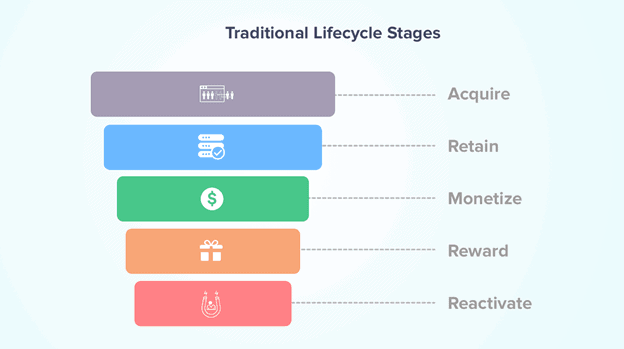
Image courtesy of Astute Solutions
What is The Difference Between CLM and CRM?
At the beginning of this guide, we talked about how customer lifecycle management or CLM tools make a great complement to a customer relationship management or CRM lifecycle stages system.
This section highlights the differences between your standard CRM software and a customer lifecycle software.
More Companies Use CRM
CRM software is the standard for many companies, from small businesses to mid-sized brands all the way to your major Fortune 500s.
With a CRM software, you never have to worry about customers slipping through the cracks, as you can track everyone that enters the pipeline. You also have a recorded history of interactions with this customer, be those phone call transcripts, email exchanges, and more.
This data informs the approach your sales team will take in trying to convince the lead to buy your products and services.
In the case of EngageBay’s CRM, your get plenty of tools like call integration, lead scoring, 2-way email sync, reports for custom metrics, 360-degree contact management, visual sales pipeline, automated customer data logging, appointment scheduling, and visual deal pipelines.
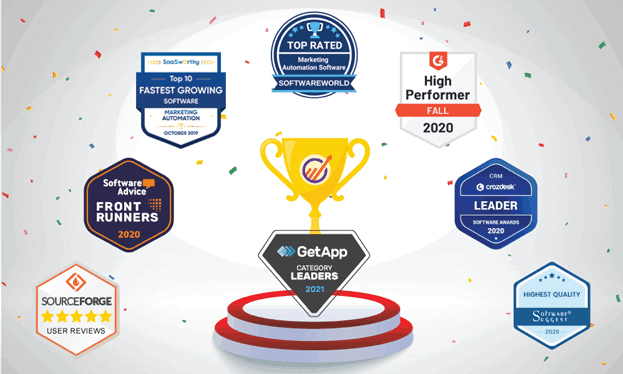
CLM Relates More to Analytics
Any good CRM software worth its salt should come with analytics. That much is true of EngageBay’s free CRM.
While the analytics and reporting offered in the average CRM software are sufficient, it’s possible to take an even deeper dive into the metrics that drive your company’s success through CLM.
In fact, some marketing experts agree that the best way to review whether your CRM approach is successful is to look at your CLM metrics. This again is a testament to the depth of reporting you can find in a lifecycle management software.
The metrics you want to focus on include:
- The cost of customer retention or acquisition: If by implementing your CRM software, you could lower the cost of converting leads to customers or maintaining customers, that’s ideal.
- Response to marketing initiatives: How much attention your audience has paid to your marketing efforts lets you know whether your CRM investment was worth it. Granted, you don’t always see wholesale positive changes right after implementing customer lifecycle in CRM software, so remember to have some patience with this metric.
- Purchasing frequency: Once you link together with your customer lifecycle management and CRM software, you’d hope the purchasing frequency from your customers would increase.
👉Boost your marketing game with our ultimate guide on the top lifecycle marketing software – don’t miss out! ⚡
Read also: 12 Great Landing Page Optimization Practices: The Ultimate Guide
How to Calculate Your Customer Lifetime Value (CLV)
The CLV is a calculation that predicts how much money your customers will bring in for your company throughout their lifecycle as a customer.
It’s partly a prediction, yes, but it’s also based on real data from your CRM that you can calculate.
Knowing the average CLV of each customer can aid your company in a variety of ways. You can determine which customers are worth prioritizing and which you can get back to later.
For example, if you group together the customers with the highest CLV, you can ensure with reasonable confidence that they’re going to buy your products/services.
So how do you calculate CLV? This image says it all:
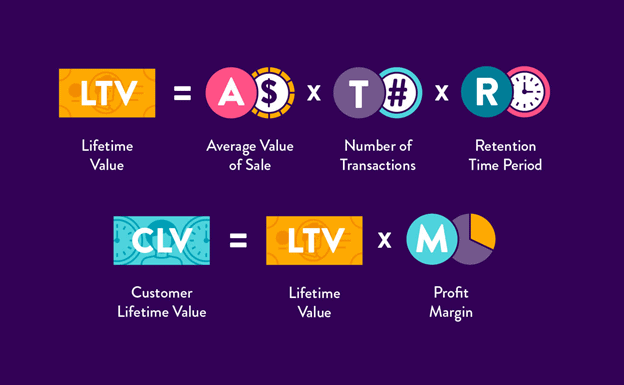
Image courtesy of CleverTap
You must also accommodate for marketing costs and acquisitions, which don’t come free. How do you get the cost of your acquisitions as a formula?
Here, you have to take your acquisition expenses and divide them by the customers you obtained through these acquisitions.
There’s also something known as return on marketing investment or ROMI. This tracks the return in dollars per dollar invested.
Read also: The Top 10 Customer Engagement Metrics and How to Use Them
How to Win at Customer Lifecycle Management
These stages are very similar to the ones we discussed before, but they have other names.
To create a customer lifecycle model graphic, also referred to as a customer lifecycle diagram, you need to knuckle down on your own customer lifecycle stages. Your customer lifecycle model may look something like this:
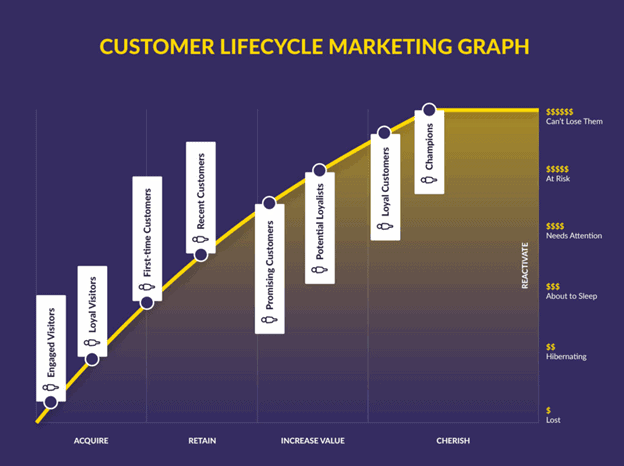
Image courtesy of Exponea
As you can see, the stages of the customer lifecycle are represented in this diagram: acquiring, retaining, increasing value, and cherishing.
The last phase, or reactivation, is left off, but it’s implied that the cycle would begin again to reactivate the customer’s interest.
Let’s talk more about what this diagram means so you can use it or something like it for your own business purposes.
Acquiring Stage
The first phase of this customer lifecycle, or the acquiring stage, focuses on engaging with your visitors. These are just websites and social media visitors and not even necessarily leads yet; they’re certainly not customers, either.
During this phase, your goal is to create a channel for communication between you and the visitor, often through opting into your email newsletter.
In your email exchanges, you could present a discount or coupon code to convince them to buy from you for the first time. You should also strive to prove the value of your products or services to incentivize that purchase.
Also as the diagram illustrates, you’re at the highest risk of losing out on these potential leads at this point in the game.
That’s mostly because you often have no concrete way to contact them yet.
Retaining Stage
Your leads then enter the second phase of the customer lifecycle or the retaining stage. Customers who have already bought from you, but want to make another purchase comes under this stage.
To encourage them to make a repeat purchase, you must keep up with your email marketing.
You want to send them offers on products or services that would be of interest to them based on their purchasing history or customer behavior on websites.
You also want to acquire feedback from these new customers, giving them discounts or coupons in exchange for their time and cooperation.
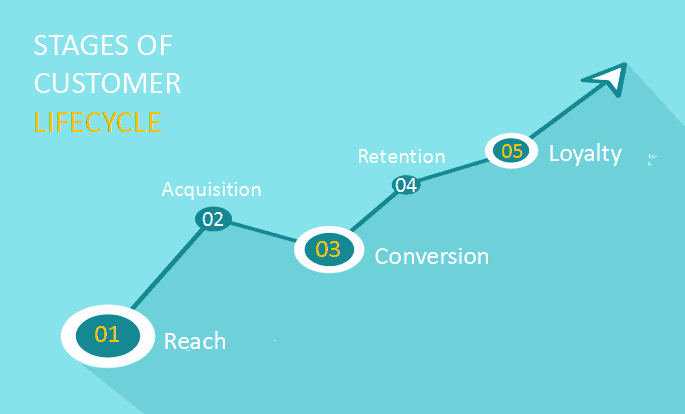
You can also send out regularly-timed promotions, trends, and other marketing material to your customers and leads — these act as lead magnets.
Referral vouchers or coupons, as well as product reviews (with discounts or vouchers), are other methods to persuade your customers to make a purchase.
Increasing Value Stage
Earlier in this guide, we talked about how it’s possible to upsell to customers while using CLM tools. Now, the time has finally come for upselling as your customers enter the high-value stage of the lifecycle.
You have two groups of customers here, the promising customer and the potential loyalist.
Your promising customers have bought more often than recent customers, although they don’t tend to generate a lot of revenue with their small-scale purchases.
You can incentivize your existing customers through a variety of marketing strategies and tactics to make bigger, better purchases.
Upselling is one such method you can use, but make sure you frame the offer as being limited edition or only available for a limited time to make the promising customer want to buy.
Then there are the loyalists — the repeat customers, the avid fans, and the brand advocates.
Cherishing Stage
Finally, your customer enters the cherishing stage, which includes your loyal customers and ‘champions.’
Your loyal customers are the backbone of your company, as they read emails, respond if necessary, and spend consistently.
They make up a good portion of your company’s revenue stream, and as such, you’re going to want to keep them around.
To do that, you could offer them personalized gifts and goods, such as team photos, personalized and signed notes, and even a gift voucher just for them.
Above your loyal customers are your ‘champions’, the real big buyers for any company. They buy from you more than anyone else and spend lots of money on your products or services.
Read also: Customer Profile: How to Create One Using CRM Software
How to Use EngageBay for Customer Lifecycle Management
EngageBay offers a phenomenal CRM software that will make tracking and managing your customers far easier. Not only that, you can ensure higher-quality leads thanks to features like lead scoring, segmentation, omnichannel marketing automation, and so much more.
The best part?
You get most of the features absolutely free. Even if you need to upgrade, you can do so for less than a dollar a day!
If you’re a small business looking for an excellent CLM software to better understand and engage with your customers, EngageBay is one great option.
Don’t believe us? Read our 5-star user reviews here.
Here’s a demo video:
Read also: 9 Customer Service Strategies from Digital Disruptors
Conclusion
In conclusion, it is crucial to emphasize the immense value of customer lifecycle management as a customer-centric and data-driven approach to effective customer management throughout the customer journey.
Implementing a robust customer lifecycle management strategy enables businesses to cultivate stronger customer relationships, leading to increased customer retention and amplified customer lifetime value (CLV).
By leveraging customer data and insights, organizations can craft targeted campaigns that are tailored to the unique needs and preferences of each segment within their evolving audience.
The benefits of embracing customer lifecycle management are manifold. Firstly, businesses can experience a notable boost in sales and revenue generation.
By delivering personalized experiences throughout the customer journey, organizations can foster stronger customer loyalty, resulting in repeat purchases and higher customer spending over an extended period.
Moreover, implementing a customer lifecycle management approach can have a positive impact on the bottom line.
By optimizing customer retention and nurturing long-term customer relationships, businesses can reduce customer churn and acquisition costs, thus optimizing their cost-to-profit ratio.
Enhanced customer satisfaction is another compelling outcome of effective customer lifecycle management.
By understanding and addressing the evolving needs of customers at various stages of the customer journey, businesses can deliver exceptional experiences, tailored offers, and relevant communication, leading to increased customer satisfaction and advocacy.
In today’s competitive landscape, adopting a customer lifecycle management strategy provides a significant competitive edge.
Businesses that prioritize understanding and engaging with their customers throughout their lifecycle are better positioned to outperform competitors, establish themselves as industry leaders, and attract a loyal customer base.
In summary, customer lifecycle management empowers businesses to thrive by maximizing customer retention, amplifying customer lifetime value, driving sales growth, optimizing profitability, enhancing customer satisfaction, and gaining a distinct advantage in the marketplace.
By embracing this strategic approach, organizations can unlock the full potential of their customer base and achieve sustainable success in today’s dynamic business landscape.
We hope that this guide article has given you some information of value. EngageBay has hundreds of blogs like this, and if you’d like to take a look, please click here.
